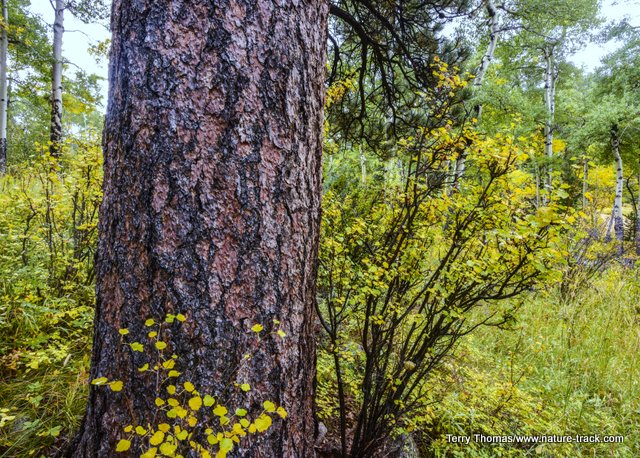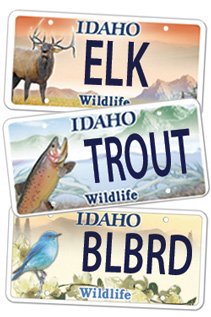Ponderosa Pine

Ponderosa pines are well adapted to low intensity fire as long as we don’t mess with things.
Driving through the Boise National Forest near Pine, Idaho, was surreal. A landscape once full of tall pines and firs was now a ghost forest of gray-black skeletons with more crisscrossing on the ground victims of a massive forest fire. This was an older burn, possibly 10-40 years old (perhaps multiple fires), and the understory had started to recover, but new growth pines and firs were still small and sparse.
As we got to camp, it was easier to really examine the damaged forest. Many of the trees that burned, and many that survived, were ponderosa pine, a giant of a tree found throughout the west from Mexico into Canada and from the plains states to the Pacific Ocean. It was unusual to see a mega fire in ponderosa habitat so, when I got home, I dug into that a little bit.
Ponderosa pine, the same tree that the ranch in the long-running T.V. series, Bonanza, was named for, has a dozen other common names, the most recognized in Idaho being yellow pine. There is even a small community named Yellow Pine, Idaho.
Yellow pine or ponderosa pine, a common tree in Idaho, and predominates throughout its range on dry slopes, often south-facing ones, from 1,000 to 10,000 feet in elevation. The further south in distribution, the higher it can grow as long as it can still reach a minimum of 150 frost-free days. It is pretty much restricted to north and west of the Snake River Plain in Idaho, meaning that we won’t find any in Eastern or Southern Idaho. Where it grows, ponderosa pine is often the plant zone that lies between the lower mountain big sagebrush/grassland and the Douglas-fir zone which starts at mid-elevations.
What makes ponderosa pine-dominated forests fire resistant is a combination of plant traits and ecology. According to the Forest Service, “Ponderosa pine has many characteristics that make it fire resistant, including deep roots; thick, relatively inflammable bark; thick scales that protect leaf and stem buds; high foliar moisture content; self-pruned or fire-killed lower branches; light to moderate lichen growth; and an open branch, crown, and stand habit.”
Ecologically, pre-European settlement, fire was common in ponderosa pine habitat. Fire scar studies indicate that fires may have occurred every 5-25 years. In effect, once a ponderosa pine stand became mature, fire would help to keep it that way by routinely burning out competing Douglas fir and other more shade-tolerant trees that could become ladder fuel and reducing forest floor litter such as needles and dead branches, thus leaving an open mature forest.
What changed that allowed the forest I drove through to burn instead of laugh off fire? Largely, the change was fire suppression. We take a dim view of forest fires that might damage property or destroy timber that humans might otherwise use. Smoky the Bear put on his hat and for many years fire was declared the enemy, at all times and in all places. Without routine low-intensity fire, ground fuels and ladder fuels built up until, when the inevitable fire did happen, it roared instead of whimpered, and tens of thousands of acres were blackened.
We have a better understanding today about the importance of fire and the role it has always played in the natural cycling of forests such as ponderosa pine. The question is, how to safely re-introduce fire and get people to embrace it rather than fear it after decades of just the opposite message.
Help Idaho Wildlife
When we traveled across the state in October 2017, we visited most of the Idaho Department of Fish and Game wildlife management areas. Most of the vehicles we saw using the wildlife management areas did not have wildlife plates. Buying wildlife plates is a great way for non-hunters and hunters alike to support wildlife-based recreation like birding.
C'mon folks, let's help Idaho's wildlife by proudly buying and displaying a wildlife license plate on each of our vehicles!
See below for information on Idaho plates. Most states have wildlife plates so if you live outside Idaho, check with your state's wildlife department or vehicle licensing division for availability of state wildlife plates where you live.
And tell them that you heard about it from Nature-track.com!

Wildlife License Plates
Great news! as of 2024, there are three NEW designs for license plates. They still are bluebird, cutthroat trout and elk, but they are beautiful.
Idaho Wildlife license plates provide essential funding that benefits the great diversity of native plants and wildlife that are not hunted, fished or trapped—over 10,000 species or 98% of Idaho’s species diversity. Game species that share the same habitats (such as elk, deer, antelope, sage-grouse, salmon, trout) also benefit from these specialty plates.
No state tax dollars are provided for wildlife diversity, conservation education and recreation programs. Neither are any revenues from the sale of hunting or fishing licenses spent on nongame species. Instead, these species depend on direct donations, federal grants, fundraising initiatives—and the Idaho Wildlife license plates.
Both my vehicles have Bluebird Plates. I prefer the bluebird because the nongame program gets 70 percent of the money from bluebird plates, but only 60 percent of the money from elk and trout plates - 10 percent of the money from elk plates supports wildlife disease monitoring and testing programs (to benefit the livestock industry) and 10 percent from cutthroat plates supports non-motorized boat access.
Incidentally, in 2014, the Idaho Legislature denied the Department of Fish and Game the ability to add new plates or even to change the name of the elk and cutthroat plates (very specific) to wildlife and fish plates, a move that would have allowed for changing images occasionally and generating more revenue. It would seem that they believe that we Idahoans don't want a well funded wildlife program.
I think it is time we let the Legislature know that Idahoan support wildlife funding and that we would like to see these generic plates come to fruition.

"WOW. What a phenomenal piece you wrote. You are amazing." Jennifer Jackson
That is embarrassing, but actually a fairly typical response to my nature essays. Since The Best of Nature is created from the very best of 16 years of these nature essays published weekly in the Idaho Falls Post Register (online readership 70,000), it is a fine read. It covers a wide variety of topics including humorous glimpses of nature, philosophy, natural history, and conservation. Readers praise the style, breadth of subject matter and my ability to communicate complex and emotional topics in a relaxed and understandable manner.
Everyone can find something to love in this book. From teenagers to octogenarians, from the coffee shop to the school room, these nature essays are widely read and enjoyed.
Some of the essays here are my personal favorites, others seemed to strike a chord with readers. Most have an important message or lesson that will resonate with you. They are written with a goal to simultaneously entertain and educate about the wonderful workings of nature. Some will make you laugh out loud and others will bring a tear to the eye and warm your heart.
Readers Write:
"You hit a home run with your article on, Big Questions in Nature. It should be required reading for everyone who has lost touch with nature...great job!" Joe Chapman
"We enjoyed your column, Bloom Where Planted. Some of the best writing yet. The Post Register is fortunate to have your weekly columns." Lou Griffin.
To read more and to order a copy, click here or get the Kindle version
Copies are also available at:
Post Register
Island Park Builders Supply (upstairs)
Barnes and Noble in Idaho Falls
Harriman State Park, Island Park
Museum of Idaho
Valley Books, Jackson Wyoming
Avocet Corner Bookstore, Bear River National Wildlife Refuge, Brigham City, Utah
Craters of the Moon National Monument Bookstore, Arco, Idaho
Wildlife License Plates
Great news! as of 2024, there are three NEW designs for license plates. They still are bluebird, cutthroat trout and elk, but they are beautiful.
Idaho Wildlife license plates provide essential funding that benefits the great diversity of native plants and wildlife that are not hunted, fished or trapped—over 10,000 species or 98% of Idaho’s species diversity. Game species that share the same habitats (such as elk, deer, antelope, sage-grouse, salmon, trout) also benefit from these specialty plates.
No state tax dollars are provided for wildlife diversity, conservation education and recreation programs. Neither are any revenues from the sale of hunting or fishing licenses spent on nongame species. Instead, these species depend on direct donations, federal grants, fundraising initiatives—and the Idaho Wildlife license plates.
Both my vehicles have Bluebird Plates. I prefer the bluebird because the nongame program gets 70 percent of the money from bluebird plates, but only 60 percent of the money from elk and trout plates - 10 percent of the money from elk plates supports wildlife disease monitoring and testing programs (to benefit the livestock industry) and 10 percent from cutthroat plates supports non-motorized boat access.
Incidentally, in 2014, the Idaho Legislature denied the Department of Fish and Game the ability to add new plates or even to change the name of the elk and cutthroat plates (very specific) to wildlife and fish plates, a move that would have allowed for changing images occasionally and generating more revenue. It would seem that they believe that we Idahoans don't want a well funded wildlife program.
I think it is time we let the Legislature know that Idahoan support wildlife funding and that we would like to see these generic plates come to fruition.